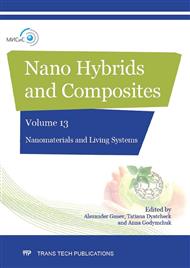[1]
S.K. Brar, M. Verma, R.D. Tyagi, T.Y. Surampalli, Engineered nanoparticles in wastewater and wastewater sludge – evidence and impacts, Waste Management. 30 (2010) 504-520.
DOI: 10.1016/j.wasman.2009.10.012
Google Scholar
[2]
A.S. Karakoti, P. Munusamy, K. Hostetler, V. Kodali, S. Kuchibhatla, G. Orr, J.G. Pounds, J.G. Teeguarden, B.D. Thrall, D.R. Baer, Preparation and characterization challenges to understanding environmental and biological impacts of nanoparticles, Surf. Interface Anal. 44 (2012).
DOI: 10.1002/sia.5006
Google Scholar
[3]
V. Shah, S. Shah, H. Shah, F.J. Rispoli, K.T. McDonnell, S. Workeneh, A. Karakoti, A. Kumar, S. Seal, Antibacterial activity of polymer coated cerium oxide nanoparticles, PLoS One, 7(10): e47827 (2012) doi: 10. 1371/journal. pone. 0047827.
DOI: 10.1371/journal.pone.0047827
Google Scholar
[4]
N.S. Taylor, R. Merrifield, T.D. Williams, J.K. Chipman, J.R. Lead, M.R. Viant, Molecular toxicity of cerium oxide nanoparticles to the freshwater alga Chlamydomonas reinhardtii is associated with supra-environmental exposure concentrations, Nanotoxicol., 10(1): 32-41 (2015).
DOI: 10.3109/17435390.2014.1002868
Google Scholar
[5]
M.A. Maurer-Jones, I.L. Gunsolus, C. J. Murphy and C.L. Haynes, Toxicity of Engineered Nanoparticles in the Environment, Anal. Chem., 85(6) (2013) 3036-3049.
DOI: 10.1021/ac303636s
Google Scholar
[6]
Yu.N. Morgalev, N.S. Khoch, T.G. Morgaleva, E.S. Gulik, G.A. Borilo, U.A. Bulatova, S. Yu. Morgalev and E.V. Ponyavina, Biotesting Nanomaterials: transmissibility of nanoparticles into a food chain, Nanotechnol. in Russia. 5 (2010) 11-12.
DOI: 10.1134/s1995078010110157
Google Scholar
[7]
Microbiological and molecular genetic evaluation of the impact of nanomaterials on the representatives microbiocenosis, Federal Center of Hygiene and Epidemiology Rospotrebnadzora. Moscow (2010) 58.
Google Scholar
[8]
Yu.N. Morgalev, T.G. Morgaleva, Yu.S. Grigoriev. Method of determining the toxicity index nanopowders products from nanomaterials, nano-coatings, waste and sewage sludge containing nanoparticles to modify the optical density of the test culture algae Chlorella (Chlorella vulgaris Beijer), FR. 1. 39. 2010. 09103.
Google Scholar
[9]
OECD Guidelines for the Testing of Chemicals, Section 2: Effects on Biotic Systems Test No. 201: Freshwater Alga and Cyanobacteria, Growth Inhibition (2011).
DOI: 10.1787/9789264069923-en
Google Scholar
[10]
A.A. Shlyk, Determination of chlorophylls and carotenoids in extracts of green leaves, Biochemical methods in plant physiology, Moscow, Nauka, (1971).
Google Scholar
[11]
Yu.N. Morgalev, N.S. Khoch, T.G. Morgaleva, G.E. Dunaevsky, S. Yu. Morgalev. Bioassay methods safety of nanoparticles and nanomaterials, Methodological Guide. Tomsk, (2010).
Google Scholar
[12]
Yu.N. Morgalev, T.G. Morgaleva, Yu.S. Grigoriev. Method of determining the toxicity index nanopowders products from nanomaterials, nano-coatings, waste and sewage sludge containing nanoparticles mortality test organism Daphnia magna Straus. FR. 1. 39. 2010. 09102.
Google Scholar
[13]
OECD Guidelines for the Testing of Chemicals, Section 2: Effects on Biotic Systems Test No. 202: Daphnia sp. Acute Immobilisation (2004) 12 p.
DOI: 10.1787/9789264069947-en
Google Scholar
[14]
OECD 202 Guidelines For the Testing of Chemicals, Daphnia sp., Acute Immobilisation Test and Reproduction Test (1984).
DOI: 10.1787/9789264069947-en
Google Scholar
[15]
Nanomaterials and superfine materials, production and consumption waste, sewage sludge containing of nanoparticles. Aquatic disperse systems. Index toxicity test-organism mortality Danio rerio, STO TSU 143-(2015).
Google Scholar
[16]
OECD 203 Guideline for Testing of Chemicals. Fish. Acute Toxicity Test. (1992).
Google Scholar
[17]
OECD 236 Guidelines for the Testing of Chemicals. Fish Embryo Acute Toxicity (FET) Test (2006).
DOI: 10.1787/9789264203709-en
Google Scholar
[18]
Globally Harmonized System of Classification and Labelling of Chemicals (GHS). The fifth revised edition. UN (2015).
DOI: 10.18356/925a27c1-en
Google Scholar
[19]
Order # 511 of the Russian Ministry of Natural Resources, The criteria for classifying hazardous waste hazard class for the environment (200)1.
Google Scholar
[20]
S. Yu. Morgalev, T.G. Morgaleva, Yu.N. Morgalev, I.A. Gosteva, Stability of Disperse Systems during Bioassay of Nanoecotoxicity with use of Aquatic Organisms, Adv. Mater. Res. 1085 (2015) 424-430.
DOI: 10.4028/www.scientific.net/amr.1085.424
Google Scholar
[21]
A. Villem, P. Suman, S. Mariliis, M. Monika, M. Lutz, K. Anne, Toxicity of 12 metal-based nanoparticles to algae, bacteria and protozoa, Environmental Science: Nano, 2 (2015) 630-644.
Google Scholar
[22]
K. Van Hoecke, J.T.K. Quik, J. Mankiewicz-Boczek, K.A.C. De Schamphelaere, A. Elsaesser, P. Van der Meeren, C. Barnes, G. McKerr, C.V. Howard, D. Van De Meent, K. Rydzynski, K.A. Dawson, A. Salvati, A. Lesniak, I. Lynch, G. Silversmit, B. De Samber, L. Vincze and C.R. Janssen, Fate and effects of CeO2 nanoparticles in aquatic ecotoxicity tests, Env. Sci. Technol. 43 (2009).
DOI: 10.1021/es9002444
Google Scholar
[23]
H. -C. Holten, L. Nanna, B. Hartmann, A. Brinch, J. Kjølholt, A. Baun, Environmental effects of engineered nanomaterials Estimations of Predicted No-Effect, Concentrations (PNECs) Env. Project. 1787 (2015).
Google Scholar
[24]
N.J. Rogers, N.M. Franklin, C. Apte et al, Physicochemical behavior and algal toxicity of nanoparticulate CeO2 in freshwater, Env. Chem. 7 (2010) 50-60.
Google Scholar
[25]
P. Vallotton, B. Angel, M. Mccall, M. Osmond & J. Kirby, Imaging nanoparticle-algae interactions in three dimensions using Cytoviva microscopy, J. Microscopy. 257(2) (2015) 166-169.
DOI: 10.1111/jmi.12199
Google Scholar
[26]
L. Song, M.G. Vijver, G. R. de Snoo and W.G.M. Peijnenburg, Assessing Toxicity of Copper Nanoparticles Across Five Cladoceran Species, Environmental Toxicology and Chemistry. 34(8) (2015) 1863–1869.
DOI: 10.1002/etc.3000
Google Scholar
[27]
A. Farooq, L. Xiaoyi, Z. Ying, Y. Hongzhou, An in vivo evaluation of acute toxicity of cobalt ferrite (CoFe2O4) nanoparticles in larval-embryo Zebrafish (Danio rerio), Aquatic Toxicol. 166 (2015) 21-28.
DOI: 10.1016/j.aquatox.2015.07.003
Google Scholar
[28]
B. Mansouri, A. Maleki, S.A. Johari, N. Reshahmanish, Effects of cobalt oxide nanoparticles and cobalt ions on gill histopathology of zebrafish (Danio rerio), AACL Bioflux. 8(3) (2015) 438-444.
Google Scholar


